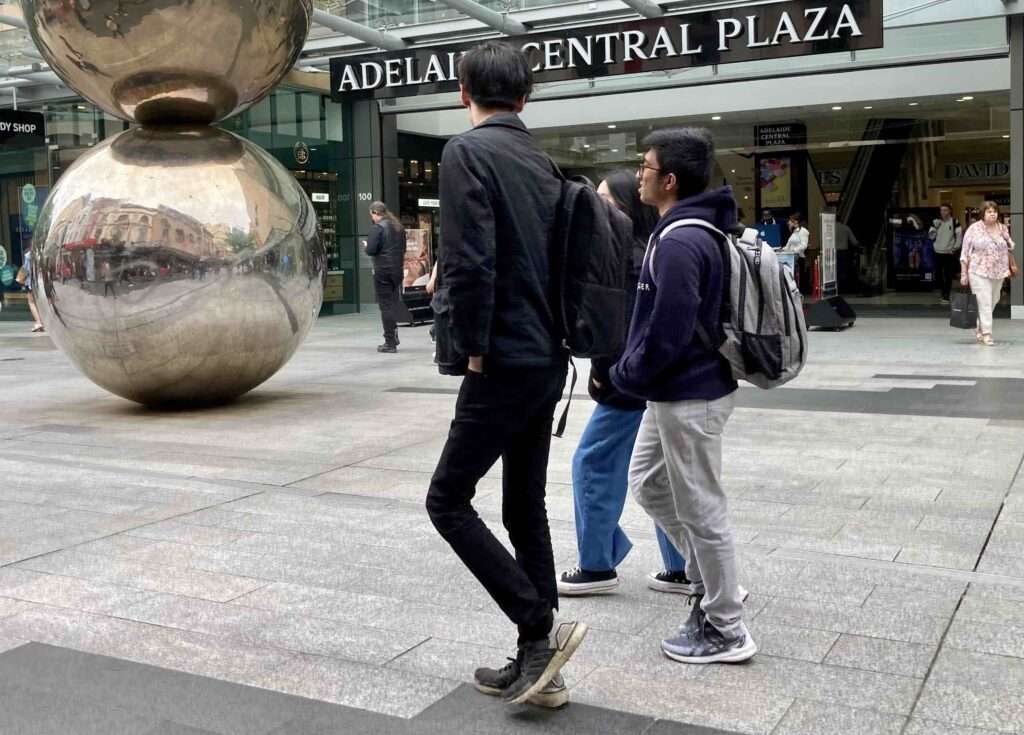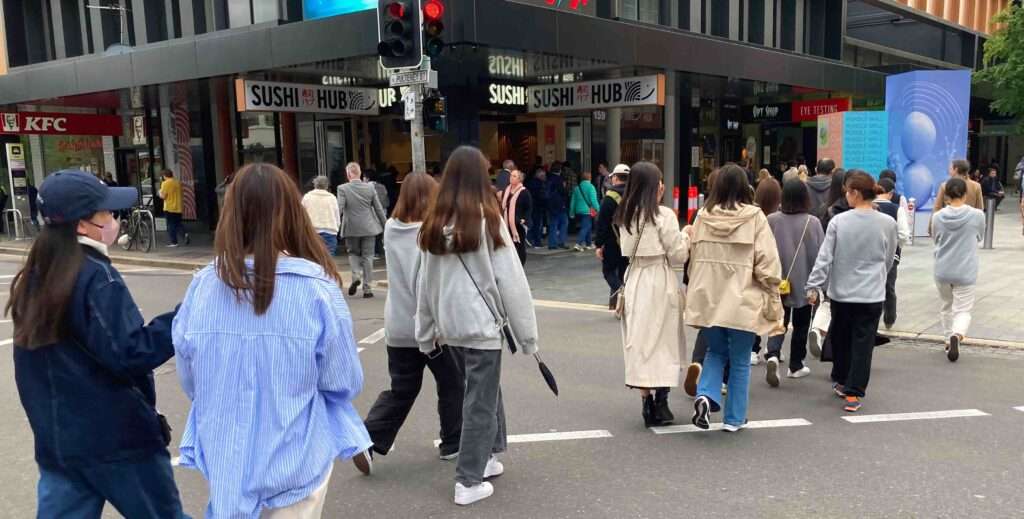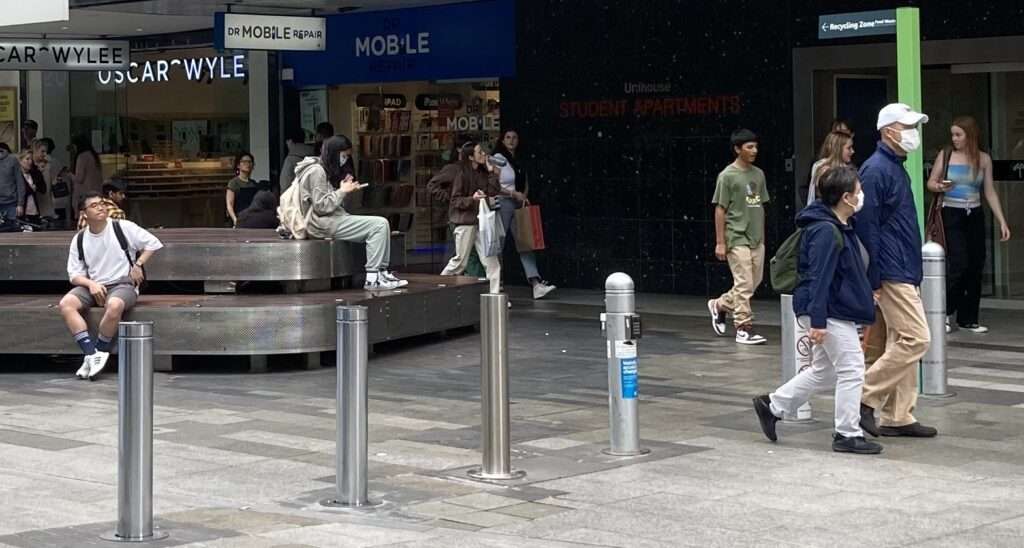When we first moved to the city, Adelaide’s international students were already prominent by their presence.
This was more than 20 years ago. Not in the numbers that we see now but it was already evident then. You could not miss them. At that time I was trying to figure out why they stood out compared to other cities.
You spot them just as the university term is about to start. New students, some accompanied by their parents are familiarising themselves with the surrounds and also shopping for essentials for their new life. Those into the second year or later are catching up with classmates and friends.
The main reason for international students standing out in the city compared to Sydney, Melbourne or Perth is that the city is much smaller than the others. And much of the facilities and amenities are concentrated within the city centre. There is a reason why Adelaide is often called the ”20 minute city”.
Convenience
Rundle Mall, the heart of the city is a short strip and the retail brands are concentrated there. It is also an obvious and convenient gathering location for meals, meet-ups and just mall cruising between classes. It is an easy landmark for everyone.

The Mall is convenient for new students who need to stock up on food and daily essentials. Previously there was only Woolies, now there is Coles.
Another good reason and probably reason for international students milling at the mall is the proximity of schools and universities. Both Universities are on the next parallel road to Rundle Mall. The schools and colleges that cater to international students are either in the city precinct or close by. Hence the mall cruising comment.
There is Adelaide University and the University of South Australia across the road. Eynesbury College, a long standing private institution which provides pathway access to all 3 State Universities. They have form 6 and foundation classes for local and international students and they are in the vicinity.
One end of Rundle Mall also houses a University hostel. It is an odd tenant for the main strip but it only walking distance to the classes. Interestingly it never stood out of place at the Mall.

Economic importance to South Australia
The international students presence in the city did strike a chord. Did not realise its impact until I came across some articles and saw figures related to the industry. I was taken aback on its impact to the State.
Here are some fast facts albeit taken in 2017 as I could not locate anything current.
International education sector was the largest export in the service sector to the State and the second largest export earner after alcoholic beverages(read our world famous wines).
In 2017, they brought in 1.4B AUD in fees. The State however accounted for only 4.5% of international students that Australia as a country took in.
Below is the impact on the economy in 2017 for every student enrolled. They bring in funds into the economy, create jobs and not just fees. Money from parents back home for living expenses. Jobs are what we need for SA locals.

Universities for example have to open up more classes, recruit additional staff to lecture and tutor these students.
Growth in enrolment also means growth in support services and indirect functions. More amenities such as opening up food courts and canteens with more catering and service staff within the premises.
Parents flying in will need hotel spaces and they are also likely to see the local tourist sites, our famous vineyards, meals in cafes and restaurants. It all adds up.

The international student demographics
The vast majority are from China, South East Asia and India. This is expected to continue as the main geographic source for the sector. Recent trends indicate students from Nepal and South America
These international students cannot be mistaken for new migrants. Despite we attracting migrants from these very regions.
You can sort of tell the international students and the migrants apart. From their attire, mannerisms and general disposition that they are international students.
The emergence of South American market is a pleasant surprise. That far-away Australia appealed to students from that part of the Word is indeed pleasing.
Those who could afford overseas eduction from South America traditionally headed to the United States due to proximity and familiarity. There are also large South American communities in the US so there is a ready support base as well.
The medium of instruction in the US is also English so I wondered what the pull factor to Australia is. One factor is the possibility of eventual migration as Australia is constantly looking to grow the country.
Again these students are mainly enrolled in the Higher Education sector such as Universities.
The State’s top private schools in Adelaide have been educating and boarding international students for years. Long before the development of the education sector as a revenue earner. Their mix is different. Typically the scions of wealthy families of South East Asia and in smaller numbers from the Far East.
The pull of Adelaide
Besides targeted education agency marketing and networking, Adelaide has some interesting reasons for bringing in international students. Remember we are competing with Melbourne, Sydney and Perth.
Melbourne and Sydney have scale in terms of tertiary institutions as well as the support amenities from food outlets to accommodation options. Perth is closer to South East Asia with daily flights to these cities. So Adelaide has a challenge.
Adelaide pull factors would be the smallness of the city and the ready access to amenities and facilities. Everything imaginable is a walk, bike or tram ride away. It is not as daunting as the big cities. Convenience is an important factor. The bohemian feel of the city also helps.
My kids had international and interstate students as classmates and they all seemed to live, study, play and party within the city centre.
Those who graduated and remained in Adelaide continue to find accommodation in or near the city during their early working years. I suppose it was too convenient to go elsewhere.
Secondly safety and security I suspect is another key factor. You seldom hear of international students having issues in the press and on social media.
Nearly a decade back there was a string of robberies and assault targeting international students in one of the main big cities that made the news for sometime. Unfortunately it also made the World news and not at all good for Australia. Adelaide was one of the cities that was spared.
When I talked to my kid’s classmates I can sense their calm and confidence of living in Adelaide. Safety concerns never came up at all.
Quality of an Australian education
Besides sports, Australia seems to punch above it’s weight in academia and education in term of quality and recognition.. For sport we do very well on the World stage such as the Olympics despite our population size. I sense the same for academia and education.
As of May 2023 Australians have been awarded the Nobel Prize 14 times from 1915 to 2011. It scored in 4 out of the 5 original Nobel categories with the exception of the Peace category. Half of these are in the field of Physiology or Medicine. So we are talking about the hard academic disciplines.
Since 2000, we scored 4 times so we are still pacing ourselves well in recent years. It reflects strongly on the country’s strength in academia, education and research.
In addition to the 14, we also have South African born and raised J.M. Coetzee, the Nobel laureate for literature. Coetzee is a renown author, having won the Booker Prize twice, an academic don who moved to Adelaide, Australia permanently.
The Fields Medal, the mathematics equivalent of the Nobel prize has been awarded to Australians, Terence Tao in 2006 and Akshay Venkatesh in 2018.
Both their parents migrated to Australia and they were raised here. Terence went to school and then to Flinders University in Adelaide while Akshay with school and then University of Western Australia in Perth.
Both have moved since to the US to pursue academic careers in renown institutions. Terence Tao is regarded as the greatest living mathematician.
Our position of advantage
These accomplishments in the field of academia and education, the English medium of instruction, our developed status and our position in this part of the World helps.
We are also far away from Europe and the US and Canada which puts us in a highly distinctive position as the geographic leader of this wider region. A position of comparative advantage.
A position which we must continue to reap the potential.
Aspiring parents and young students in Asia and the Pacific are always looking to further their lot. Multi-national and elite companies rate a degree from a 1st World and developed country much higher. There is always a premium. And Australia can help in that journey.
As long as we continue to see International students milling around Rundle Mall and the inner city we know we are on the right track in developing the sector.
The competition remains with Australian cities and not elsewhere. It’s ours to give it up.
One other thing though. It will be good if the State authorities do regular media releases on the international student segment and what it does for the State. Including annual figures, countries they comes from etc.
These help public and commercial interest to appreciate the potential. Be it in academia or in support services such as building students digs and hostels to little things such as laptop sales and services.
Go for it Adelaide and the State of South Australia.
